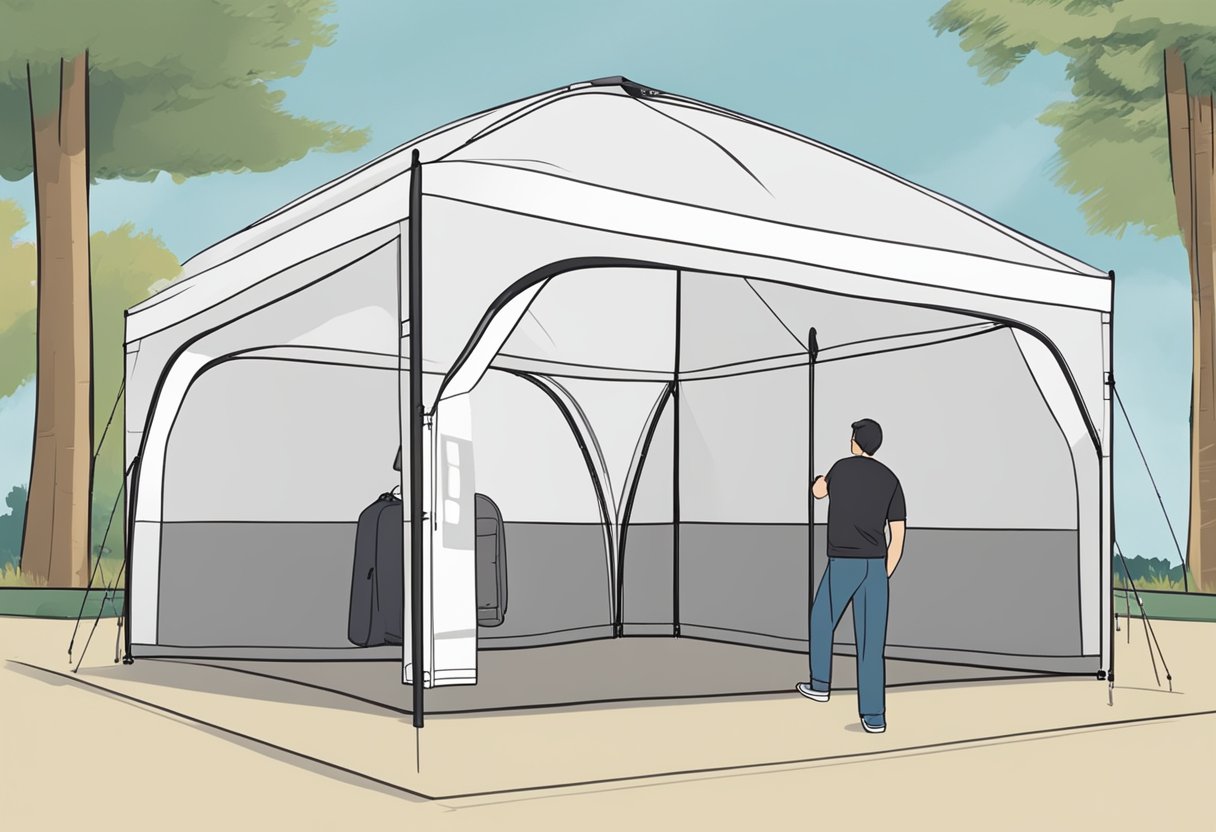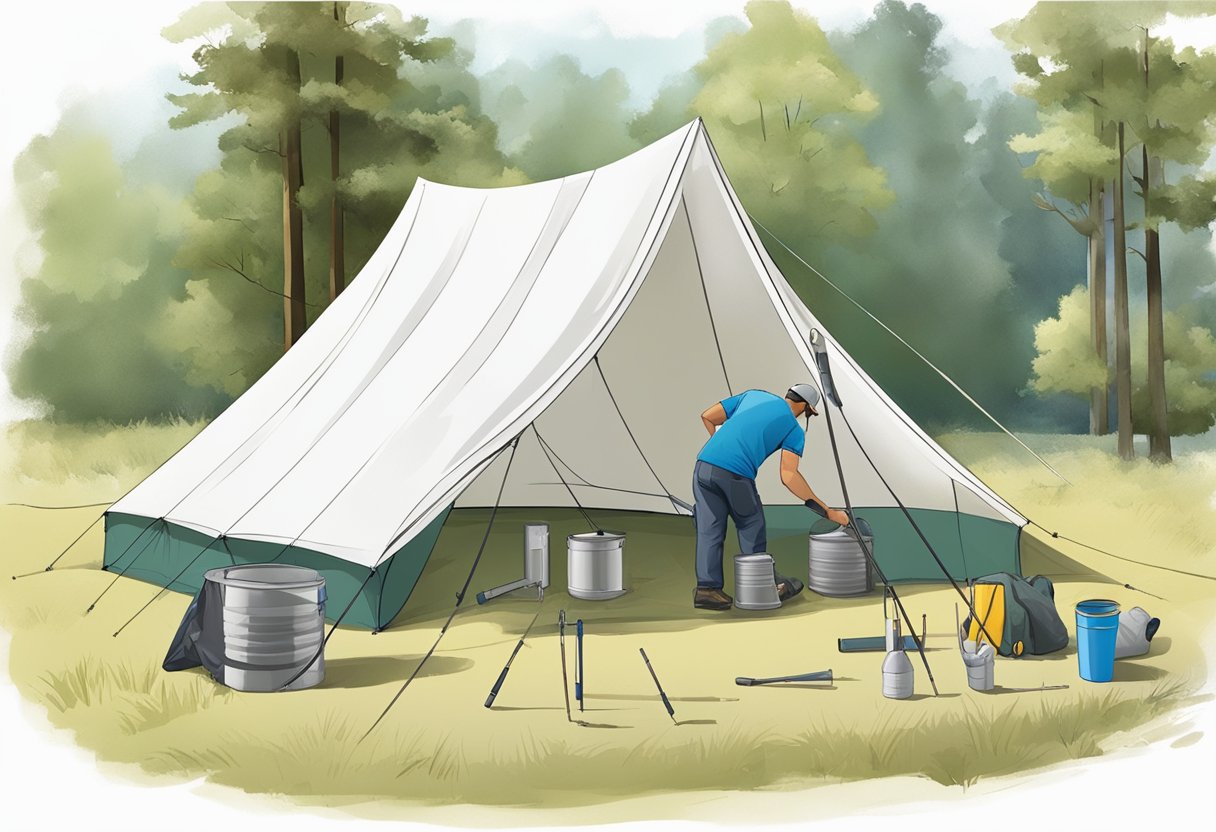10×10 Tent Buyer’s Guide: Top Picks for Your Outdoor Adventures
A 10×10 tent is a versatile shelter often used for a variety of outdoor events and activities. Its dimensions make it large enough to accommodate groups while remaining compact enough for easy transport and setup. The structure typically consists of a durable fabric canopy supported by a framework of metal poles or telescoping legs. Due to its balanced size, a 10×10 tent is a popular choice for vendor booths at markets, tailgating, family picnics, or as a temporary outdoor station.

When it comes to selecting the right model, consumers are presented with an array of designs and features. These canopies can come equipped with features such as UV protection, waterproof materials, and easy pop-up mechanisms that cater to both recreational and commercial needs. Brands have developed various product lines to satisfy specific customer requirements, offering a range of tents that emphasize strength, ease of use, or portability. It is essential to consider the intended use, as a beachgoer might favor a lightweight tent for quick shade, while a market vendor might need a sturdier structure for regular use.
Key Takeaways
- 10×10 tents provide a functional and portable shelter solution for various outdoor settings.
- These tents feature a range of design options and built-in functionalities from different brands.
- When purchasing a 10×10 tent, considerations include intended use, durability, ease of setup, and available accessories.
Key Features of 10×10 Tents
When selecting a 10×10 tent, vital features to assess include the materials used for durability and the tent’s design for simple setup and disassembly. These factors greatly influence the tent’s functionality and longevity.
Material and Durability
Materials: The fabric canopies of many 10×10 tents typically utilize polyester or vinyl. Polyester offers a balance of affordability and resilience, whereas vinyl is prized for its increased durability and resistance to water, making it suitable for various weather conditions. The frames are often made of materials like aluminum or steel, which provides sturdiness without excessive weight.
- Durability Features: A robust frame, usually constructed from a 40mm or 50mm aluminum profile, bolsters the tent’s stability. For enhanced weather resistance, reinforced stress points, ground stakes, and guy ropes are key characteristics that improve the tent’s ability to withstand wind and other elements.
Ease of Setup and Disassembly
Design Functionality: The 10×10 tent’s design focuses on ease of use. The pop-up mechanism aids in rapid assembly, typically achievable by one or two people. Push-button sliders and pull-pin systems contribute to a setup that’s both quick and secure.
- Disassembly: The process is streamlined, with tents collapsing efficiently, often into a compact form that facilitates convenient transport and storage. This quick breakdown is a critical feature for those who use their 10×10 canopy tent for events and require a hassle-free take-down.
Popular Designs and Brands
When considering a 10×10 tent, potential consumers will find a range of options tailored for different uses from camping to commercial events. The market offers tents designed with varying features that cater to specific needs such as durability, ease of setup, and versatility.
Commercial vs. Recreational Tents
Commercial Tents are typically built for durability and frequent use. They often feature heavy-duty materials with wind ratings and waterproofing to withstand variable weather conditions. Businesses might opt for the Zoom brand, designed to excel for trade shows, markets, and other vendor events.
Recreational Tents, on the other hand, prioritize portability and comfort for casual outdoor activities. Brands like Marmot and REI offer 10×10 models that stand out for their user-friendly designs, ideal for family outings or beach visits.
Innovative 10×10 Tent Designs
Manufacturers are continually pushing the envelope in tent design, integrating features that enhance the user experience. Innovations in 10×10 tent designs include minor changes to entry doors and additional inside capacity for more livable space. For example, some models offer top mesh pockets for storage and improved ventilation systems. These designs can be found in tents like the Black Diamond’s updated 10×10 models, which balance innovation with functionality.
TentCraft’s E-Series and X-Series frame tents represent the shift towards innovation with their certified wind ratings and the canopy top constructed from heavy-duty 18oz vinyl — a testament to the advancements in 10×10 custom canopy tent durability and performance in commercial settings. These tents are perfect for businesses that need a semi-permanent, sturdy structure for recurring events.
Buying Guide

When selecting a 10×10 tent, one must scrutinize essential aspects to ensure the purchase meets their requirements. This section delineates specific factors for consideration and details the vital specifications of the tents.
Factors to Consider When Purchasing
- Purpose: Identify the primary usage of the tent, be it for craft shows, farmers’ markets, or outdoor recreation. The purpose will influence the type of tent features that are prioritized.
- Durability: Look for materials that offer longevity and can withstand various weather conditions. Quality of fabric and robustness of poles are central to this.
- Ease of Use: Ascertain the tent’s ease of setup and takedown. A tent that is user-friendly can save time and reduce stress at events.
- Portability: Consider the weight and packed size of the tent. It should be light enough for easy transport yet sturdy enough to resist wind and rain.
- Cost: Tents come in varying price ranges. Determine the budget and seek the best value within that financial parameter without compromising on the necessary features.
Understanding Tent Specifications
- Dimensions: A 10×10 tent should have a base that measures exactly 10 feet by 10 feet. The height of the tent and whether the legs splay should also be considered, as it influences the usable space.
- Weight: The total weight can affect transportation and ease of setup. A tent without side walls will generally be lighter than one with side additions.
- Materials:
Component Preferred Material Options Tent Fabric Polyester, Vinyl, or Canvas Frame Material Steel or Aluminum Weatherproofing Water-resistant coatings - Accessories: Extra features such as sidewalls, weight bags, and rain flies should be considered for additional protection against weather elements.
By taking these factors and specifications into account, one can select a 10×10 tent that adequately caters to their needs while ensuring quality and functionality.
Maintenance and Care

Proper maintenance and care are crucial for maximizing the longevity and preserving the functionality of a 10×10 tent. This involves routine cleaning, appropriate storage, and timely repairs using quality products.
Cleaning and Storage
To clean a 10×10 tent, one needs to start by setting up the tent in a shaded area or indoors. It’s important to use lukewarm water and a mild, non-detergent soap, avoiding harsh scrubbing, which can damage the tent fabric. A specialized tent cleaner helps to ensure that the material maintains its waterproofing and breathability. Make sure the tent dries completely to prevent mildew.
Storage Tips:
- Always store the tent in a cool, dry place.
- Avoid compressing the tent into a tight space, which can add stress to the material and seams.
Repair Tips and Tricks
For repairs, one should identify areas in need of attention, such as seams and fabric tears. A tent repair kit is a valuable set of tools that can address most common issues. This may include seam sealer for leaks and patches for holes or tears.
- Use a foam brush for applying seam sealant accurately.
- Small pinholes can be remedied with a dab of sealant.
- Follow product instructions for cure times to ensure a durable repair.
Where to Buy 10×10 Tents

When in the market for a 10×10 tent, potential buyers have a variety of options ranging from online marketplaces to local retailers. These options cater to different preferences, whether one seeks comprehensive online listings or the tangible shopping experience of a local store.
Online Marketplaces
Online marketplaces are a convenient starting point for comparing a broad selection of 10×10 tents. Shoppers can view inventory levels and compare local store prices seamlessly. The Home Depot offers an assortment of these camping tents, with detailed product descriptions and customer reviews. Another substantial source is Amazon, where buyers will find a wide range of options with varying prices and features.
Local Retailers
Visiting local retailers can help consumers assess the tent’s material and build quality in person. Home Depot outlets often have tents on display, allowing for hands-on inspection and immediate purchase without shipping wait times. Moreover, these stores sometimes offer exclusive in-store deals, providing further incentive to visit. Keeping an eye on local inventory levels through the retailer’s website helps ensure the item is in stock before making the trip.
Tent Accessories
When choosing accessories for a 10×10 tent, it’s important to consider products that enhance the tent’s functionality and fit the intended use. Quality accessories can transform a standard tent into a well-equipped space for a variety of activities.
Enhancing Your Tent’s Functionality
Walls and Sidewalls: Enhance a tent’s shelter capabilities by adding tent sidewalls. They offer protection from the elements and can be waterproof and fire-retardant, providing both safety and comfort.
Weights and Anchors: To ensure stability, especially in windy conditions, consider using heavy-duty weights or sandbags for anchoring. These products prevent the tent from shifting or tipping.
Canopy Top: Opt for a high-quality, heavy-duty vinyl canopy top with hot-air-welded seams for waterproofing. They offer long-term use and can withstand various weather conditions.
Accessorizing for Different Uses
Custom Branding: For business events, custom branding on the tent’s surface presents a professional image. This can be done through custom printed materials that showcase company logos or messages.
Lighting: Provide illumination with LED lights or lanterns for evening events. These can be hung from the tent frame or placed around the tent’s perimeter for optimal lighting.
- Tables and Chairs: Furnish the tent’s interior with portable tables and chairs to accommodate guests or display products, creating a welcoming setting for a multitude of events.
Each accessory adds a layer of functionality and customization to the 10×10 tent, catering to the specific needs of the user. Whether for a craft fair, a wedding, or a corporate event, the right accessories can significantly boost the utility and appeal of the tent.
Customer Support
When purchasing a 10×10 custom canopy tent, an integral part of the service is customer support, which encompasses warranty and return policies, as well as the availability of assistance and resources. Reliable manufacturers ensure customers have access to comprehensive information and support channels, including websites and contact numbers.
Warranty and Returns
Manufacturers of custom 10×10 tents typically provide a warranty that covers defects in materials and workmanship. It’s crucial for buyers to understand the warranty’s length and what components it covers before making a purchase. For returns, many companies offer a period within which the tent can be returned, but it is subject to terms and conditions found on their website. The return process usually requires contacting customer support to initiate the procedure.
Contact Information for Warranty and Returns:
- Website: Access to return policies and warranty information.
- Phone: Call for assistance – 1-800-430-3376 (standard carrier rates may apply).
- Texts: Some vendors may also offer support through text messages.
Assistance and Resources
Customers often need assistance during or after the purchase of their 10×10 tent, ranging from setup queries to dealing with screen reader problems for visually impaired users. Sellers provide various resources.
Safety and Regulations
When setting up a 10×10 tent, one should not overlook the importance of adhering to established fire codes and weight requirements for safety.
Compliance with Local Regulations
Every community has fire and safety regulations in place to ensure public safety, especially regarding structures like a 10×10 tent. It is imperative to consult the 2021 International Fire Code for general guidelines. One must also obtain any necessary permits and adhere to local regulations, including size restrictions or required distances from other structures.
Safety Precautions
In terms of anchorage, a 10×10 tent typically requires substantial weight to maintain stability. It is recommended to use 30-40 lbs per leg under normal conditions while increasing it to 75-125 lbs per leg in windy scenarios, as underscored by guidelines found at MVP Visuals. Furthermore, an emphasis on fire-retardant materials is critical for safety, allowing guests a safer environment. Each tent should have easily accessible exits and should maintain a clear space around the tent for emergency access. Fire extinguishers should be within reach, and electrical installations need to follow safety codes to prevent hazards.
10×10 Tent Uses and Applications
The 10×10 tent, a versatile structure, serves various functions across multiple domains. Businesses frequently use these tents for promotional events and fairs, capitalizing on the designs that are both practical and aesthetically pleasing. They can easily brand these canopies with logos and corporate colors for effective marketing.
Designs of 10×10 tents often feature a simple, sturdy frame supporting a fabric canopy. This functionality allows for quick assembly and disassembly, an essential element for vendors at craft shows or farmers’ markets. Some designs incorporate features such as high peak roofs or customized sidewalls, enhancing visibility and shelter.
Commonly, the 10×10 tent finds itself as an integral part of outdoor gatherings, such as weddings or community events. Its compact size fits within the regulations (RUL) for most outdoor venues, assuring compliance while providing ample cover for merchandise, food stations, or seating areas.
Sports teams and recreational clubs take advantage of these tents’ easy transport and swift setup for providing sidelines shelter during tournaments and meets. Similarly, families often employ the 10×10 canopy for beach outings or picnics, effectively expanding their outdoor living space.
- Businesses: Outdoor trade shows, promotional campaigns
- Market Vendors: Farmers’ markets, art fairs
- Events: Weddings, community gatherings
- Recreational: Sports events, family outings
In each application, the need for a balance between portability and stability defines the selection of a 10×10 tent. Whether they are used as a temporary storefront or a custom-designed enclosure for specific technology, these tents continue to offer a practical solution for diverse outdoor needs.
Frequently Asked Questions
In this section, one will find answers to common queries regarding 10×10 tents, directly addressing the specifics of capacity, stability, space utilization, material, customization, and purchasing.
How many people can comfortably be accommodated under a 10×10 tent?
A 10×10 tent typically accommodates 10 to 15 people standing or 6 to 8 seated guests, allowing for a comfortable gathering space.
What are the best practices for securing a 10×10 tent in windy conditions?
To secure a 10×10 tent in windy conditions, it is recommended to use weighted bags on each leg and ensure all guy-lines are properly anchored.
How many tables can be arranged within a 10×10 tent for an event?
One can arrange either one banquet table or up to four round tables within a 10×10 tent, depending on the specific layout and intended use.
What materials are commonly used for heavy-duty 10×10 tents?
Heavy-duty 10×10 tents are usually made with high-grade steel or aluminum frames and polyester or vinyl canopies for enhanced durability and weather resistance.
Are there custom branding options available for 10×10 tents?
Many companies offer custom printing options for 10×10 tents to display logos or branding, perfect for events and businesses. All of the tents sold by American Image Displays are offered with full color custom printing.
